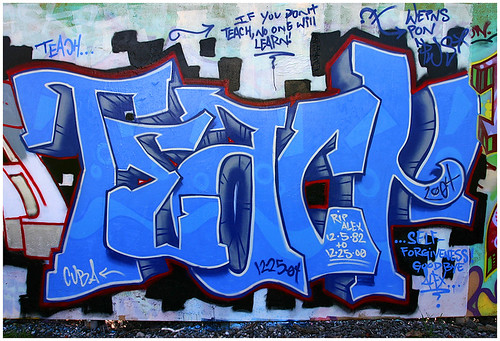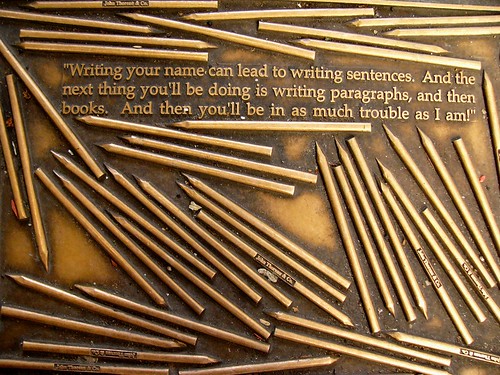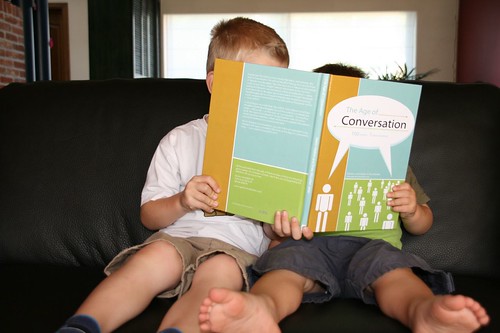
This week’s post will be a little bit different from my usual fare. Instead of writing about or using other authors’ works as examples of good writing, I’ll be using my own.
The following essay was an assignment I had to complete for my graduate Composition class. Despite it being an academic paper, it lacks a thesis statement because it is a narrative essay (one of the only academic essay types informal enough to allow for implicit theses statements). Unfortunately, narrative essays aren’t standard assignments in most college classrooms.
Rather than using the essay as an example of how to format an academic paper (e.g., clear introduction with thesis statement, topic sentences beginning each paragraph, etc.), use it as an example of clarity of purpose. If you can give your essay to someone and they can tell you what you were supposed to write about without ever having seen your original essay prompt, then you have succeeded in answering the prompt. (That doesn’t necessarily mean you FULLY answered the prompt, just that you stayed on topic.)
The essay is also an example of how the writing process is ever ongoing. I didn’t submit this assignment because I was done writing it; I submitted it because the deadline had come. There are still quite a few parts of the essay that I’m dissatisfied with, so many changes I’d make if I still had the time. All these years in college and I’m still learning that the goal is not to be perfect – it’s to do the best you possibly can within the time frame that was given to you.
------------------------------------------------------------------------------------------
A Life Spent Reading: The Development of One Composition Instructor's Classroom Goals
Some of my earliest memories include my grandfather sitting me on his knee and teaching me how to read Spanish from Coquito1. I still have that book in my bookshelf. Its pages are yellowed and tattered now, the print difficult to read, but the words have lost none of their meaning. My grandfather's visits were few and far between, however. But fortunately for me, he was not the only one in my family who encouraged reading.
My father had me reading the classics as soon as I was able to hold a book in my hands. An intellectual who had served seventeen years in concentration camps during the Bolshevik invasion of Romania, he understood just how powerful and liberating the written word could be. He had me reading Dickens, Hardy, and Dostoyevsky all before I passed the age of 8. Much of what I read was too advanced for my understanding of the world at the time, but I would never call the exercise of reading the works wasteful. Because of my admiration for my father and his high estimation of learning, I wanted to read more, to be more cultured, so I could please him. After a while, I read to please myself.
I devoured literature. Growing up, I read all the time: before school, in between classes, during classes, and after school. I'd often stay up the entire night reading. I remember stuffing towels under my bedroom door to keep the light from giving me away; when the bits of towel poking out from under the door aroused my parents' suspicions, I switched to reading under my comforter with a flashlight. As much as I read, I'm surprised I found the time to do anything else besides homework. Somehow, though, I managed to find the time to write.
I started writing recreationally in 6th grade. My English teacher at the time, Mrs. Graves, would assign a set of vocabulary words that each had to be used in a sentence. Being the overachiever I was, I would spend the class period writing a story that used the vocabulary words instead of discrete sentences. I still remember how proud I was of all the praise I received from Mrs. Graves when I turned in the assignment. I enjoyed the attention so much, I wanted more of it and so every vocabulary assignment thereafter was a new story filled with drama, intrigue, and lexical variety.
I continued to write until I started college. Its demands on my time were such that free time for writing was a luxury I did not have. My life up to that point prepared me so that when I entered college, I entered it secure in the knowledge that I was a literate person, able to take on the reading and writing tasks that would be asked of me. That is not the reality that many people face when entering college, unfortunately. They must take the classes I placed out of to bring their literacy up to the college level. Since I plan on teaching those classes, it behooves me to take a closer look at what literacy is and how it is developed.
Literacy as it relates to the written word involves engaging with the written word on multiple levels. A person must be able to read a string of letters and understand the meaning that particular string creates. This comprehension of meaning is essential to the meaning of literacy; without it, you are left with someone who has learned to do nothing more than parrot the sound associated with each letter. The person has learned only the phonetic meaning of each letter, not its semantic meaning. When I read Japanese, I am an example of such half-accomplished literacy. I can sound out each grapheme2, but I have absolutely no idea what the final product means. I know that ごうじ is pronounced go-u-ji, but as to what it means (if anything), I haven't a clue.
Literacy involves more than just being able to read a string of letters and understand its meaning, however. A literate person must also be able to recreate those letters from memory and string them along in such a way that meaning is conveyed accurately and efficiently. This ability to write is just as essential to the definition of literacy as the ability to read is. Without it, a person's freedom is impinged upon; a person is left exposed to realities created by others without having the ability to refute them, much less the ability to create a new one. A person without the ability to write is nothing more than an answering machine – a receiver of messages without the power to create his own recorded message.
As disparate as the skills are, they are both necessary for the full definition of “literacy” to be realized. Society expects a person who is able to read proficiently to also be able to write proficiently. It is this latter skill that my students believe they need to improve. While they are correct in that regard, almost all my students lack the critical thinking skills required to read a piece of literature and see beyond the surface meaning of the words on the page. My title is “instructor of English composition,” but I really teach students how to write and read.
Just because students enroll in my classes so that I can teach them composition in no way entails that they want to learn the subject. Half of my students have convinced themselves that they are just no good at writing and shouldn't bother trying to be, resigning themselves to a semester of boring essays they'd rather not have to write. The other half is petrified of failing the class, certain they cannot possibly improve their writing skills enough to make a difference. Neither half usually likes reading.
If my childhood experiences with literature have taught me anything, it is that not only is reading a necessary component of writing well, it must also be of literature that is well written. In much the same way my father encouraged me to read the classics, students have to learn to be discerning of the quality of the literature they read in order to reap the greatest benefits from it. I don't yet know how to impart that sense of a work's literary merit to my students, but it is definitely something that I would like to include in my lessons.
Improvement takes longer than a semester to appear and, realistically, is a process that will last the entirety of a student's life. In order for that to happen, though, that student needs to continue to read even after concluding my class. The only realistic way for that to happen is if the student developed a love of literature. I want to pass on my love of reading to students, to help them discover that it can be an enjoyable activity.
In addition to passing on my love of literature, I want to pass on my enjoyment of writing to my students. I want my students to want to write, not to feel forced to do so just to fulfill a course requirement. Each negative experience students have with writing only serves to more deeply ingrain in them their dislike of the activity. I don't expect my students to become recreational writers in their spare time, but I do want them to leave my class having written at least one essay they looked forward to and enjoyed writing.
I am far from being an expert in the field, but what I lack in knowledge I make up for with enthusiasm for my job. Personal experience has taught me that reading and writing can become enjoyable activities to people who are encouraged at every step of the way. I want to be an instructor that my students respect enough to want to please, the way I wanted to please the people in my life who taught me the value of words. Seasoned with that desire and ladling out heaping servings of praise with my criticisms, I want to help my students achieve the full definition of literacy.
Notes
1Zapata-Santillana, Everardo. Coquito Clasico: Lectura Inicial. Ediciones Coquito USA.
2 I use “grapheme” instead of “letter” as Japanese does not have a one-to-one phoneme-to-written symbol correspondence with the written form of its language
Photo credit:
Wyoming Jackrabbit 



















 Quote by Henry David Thoreau. Photo by
Quote by Henry David Thoreau. Photo by 












